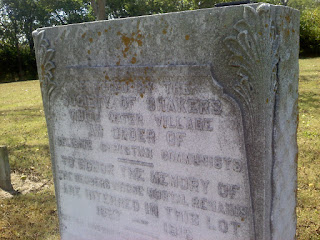 |
| kinda hard to read, see text to the right |
Erected by the Society of Shakers
White Water Village
An Order Of Celibate Christian Communists
To Honor the Memory Of The Members Whose Mortal Remains Are Interred in This Lot
1827-1916
All I really knew of the Shakers was the fact that they produced plain, durable, handcrafted furniture. Maybe similar to the Amish but with added holy roller flavor. That "Celibate Christian Communists" phrase piqued my curiosity. I set out to learn more.
 |
| One of those famous chairs |
Officially they are called the United Society of Believers in Christ's Second Coming and their worship services tended to be frenzied and ecstatic, hence the name "Shakers". The Shakers believed in equality of the sexes, the second coming of Christ, and communal living, which was called communism well before Karl Marx.
Overall they seem to fit in with 19th-century spiritualism. I've read of other communal religious societies from that time period such as the one in nearby ghost town Utopia, OH and the more famous Oneida Community in New York that claimed future President Garfield assassin Charles Giteau as a member.
It gets a bit more interesting...
 |
| Shaker Village to the North, looks nice but read the fine print |
This belief meant women took leadership roles in the church. That in itself was a radical idea in 18th century America and seems progressive on the surface. The fact is, living spaces were still segregated as were schools and work-related roles. Separate but equal I guess.
Ok, that's great, now get to the sex part. Or lack thereof.
Additionally and probably the most puzzling of all, the Shakers believed all sex was a sin and celibacy was a path to God. This didn't just apply to church leaders or the unmarried. Everyone. Mother Ann Lee taught that sex was "the root and foundation of human depravity". That's a big drawback for a commune and had to be a hard sell when they got to that page of the brochure. In fact, they didn't even believe in marriage. I guess it was OK for others to be depraved because instead of sexual procreation to multiply their flock, the Shakers adopted orphaned children into their communities and relied on conversion of adults.
 |
| 19th century Shakers shaking |
It was the US Civil War that brought on a rapid change that the Shakers could not adapt to. Major industrialization occurred in the postbellum era which started an economic decline for the Shakers. Folks were now able to purchase cheaper mass produced items instead of more expensive Shaker made goods. Membership started declining as new converts were hard to come by as the Shakers became less financially prosperous. Existing members left when they found the lifestyle too difficult to adhere to. Similar to the Amish, at age 21, folks could decide to stay or go. Additionally, adoption laws started to be reformed in the late 19th century. The Shakers were separatists in a closed society. Technological advances in transportation and communication such as trains and the telegraph altered the world and increased the difficulty of maintaining that separation. Despite the popular notion, non-traditional Protestant Christian religions were not always welcomed in the US. Just read about the hard times of the early Mormons, Quakers, and Catholics in the US. We were even debating the idea of a Catholic President in 1960. What America really had going for it was land and plenty of it. Folks could spread out a bit and stay out of each other's way. For a while.
Another odd bit, The White Water Shaker Settlement which was active from 1824-1916, south of this cemetery attracted former Millerites who believed in the April 1843 Christ's Second Coming. Maybe you heard but that didn't pan out. The Shakers convinced some of these greatly disappointed Millerites that this already occurred in the form of Mother Ann Lee.
 |
| 1816 Shaker text |
The Shakers goal was to create a working Heaven on Earth during what they believed to be the time of the second reign of the Christ spirit while practicing the value of hard work. However, it is ironic their secular contributions such as furniture and labor-saving innovations will be their true legacy and not their Celibate Christian Communism.
The Shaker movement peaked during the Civil War with 6,000 members and dozens of villages. By the 20th century there were only 12 active communities and by 2017 there was one community in Maine with 2 members.They are still open to converts.
other sources and additional reading:
- Cincinnati Enquirer 04/07/1968 article on a man who lived at the village (scroll down to the OCR text)
- Ken Burns film on the Shakers
No comments:
Post a Comment